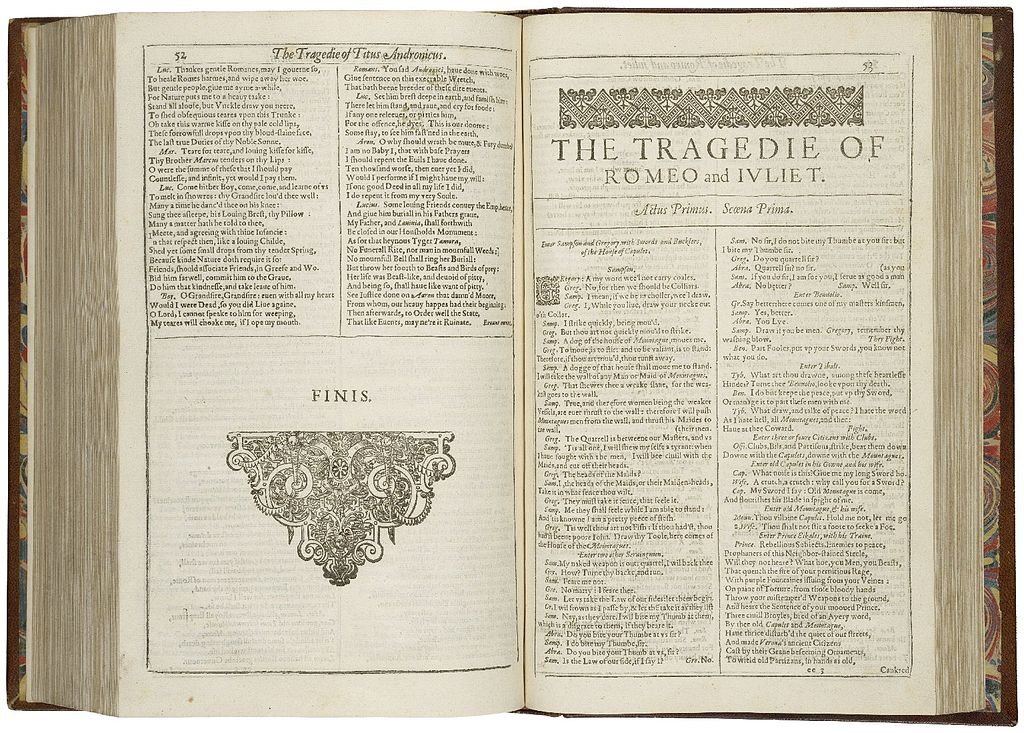
It certainly does not detract from Shakespeare’s genius to point out that his plays are usually based on other literature. He found material for his plays in the work of other writers. Romeo and Juliet, for example, is based on a sixteenth-century narrative poem by Arthur Brooke entitled The Tragical History of Romeus and Juliet first published in 1562. It’s extremely helpful to have the class read the play while listening to Caedmon unabridged audio cassettes starring Claire Bloom and Albert Finney. This procedure brings the play to life far more readily than having students (or teacher) stumble through the poetry. Stop the tape whenever questions arise; otherwise, play it for a couple of pages as students follow along in their books then discuss the section. Apart from one short passage at the end of Act IV, one should read the entire play. The time span is five days, and the setting is Verona and Mantua, cities in Italy, during the fourteenth century.
Act I
Scholars cannot explain why Shakespeare decided to include a prologue before the first two Acts that recapitulates the plot. It has been frequently observed that Shakespeare’s prologues share the same function as an ancient Greek chorus by commenting on the action for the audience; however, the omission of a prologue at the beginning of the last three Acts appears to be inexplicable. The prologue in sonnet form that preceeds Act I summarizes the main events of the play. Of particular significance is Shakespeare’s reference to the feud that causes the lovers’ deaths. In his prologue, Shakespeare emphasizes not the tragedy of young love but the fatal grudge operating in the hearts of two families. The two young people are “star-crossed” or fated to die because of this animosity. It would seem that the interminable hatred of vindictive adults appears to be Shakespeare’s concern and the focus of his play. One needs to stress that Romeo and Juliet is not merely a love story gone tragically wrong but an exploration of the long-term effects of hatred. That is its theme.
Scene 1
Act I contains the play’s exposition. The setting is Verona. A dramatist has only dialogue to convey information; the opening interchanges between the Capulets and Montagues serve to alert us to the two families’ longstanding quarrel, the cause of which has been long forgotten. Even the servants of the warring families are involved; the Capulets’ servants Sampson and Gregory deliberately provoke an argument with the Montagues’ servants Abram and Balthasar that leads to fighting. After the fathers of both families are sternly reprimanded by the ruler of Verona and threatened with death should such a riot reoccur, we learn from Benvolio and Lord Montague that Romeo has recently become listless and depressed.
This sorrowful description foreshadows Romeo’s appearance. Romeo is suffering from unrequited love for a young woman who does not appear in the play. Romeo is a typical Petrarchan lover, which means he adopts a melodramatic, idealistic attitude to love. A Petrarchan lover is steeped in melancholy and obsessed with love for an unattainable lady. Why does Shakespeare include in his play a lady we never meet? Surely he does so in order to depict Romeo’s transient love for Rosaline that contrasts with his genuine love for Juliet; Shakespeare also includes Rosaline in order to demonstrate Romeo’s impulsive personality. One could point out the oxymorons that emphasize his conflicting emotions, but the term needs defining. An oxymoron is a figure of speech that contains two seemingly contradictory terms in order to create emphasis. Commonplace oxymorons include an open secret, an everyday miracle, and a cheerful pessimist. Examples of oxymorons in this scene include the following: “loving hate…heavy lightness…cold fire, sick health.” We talk about the personality of Romeo’s friend. Benvolio lives up to his name, which means “goodwill,” and is the sort of friend we all want, sympathetic and sensible. He gives love-sick Romeo wise advice about his friend’s unrequited love for Rosaline: “Examine other beauties.”
Scene 2
A situation occurs that will become one of many stumbling blocks for the lovers: Count Paris asks Juliet’s father for permission to marry his daughter. Capulet somewhat reluctantly agrees. He invites Paris to a ball that he will hold that night. Every highschool class raises two complaints that involve Juliet: She is thirteen thus far too young to marry, and no girl in her right mind would allow her parents to choose her husband. That’s when one could repeat Samuel Taylor Coleridge’s advice: When you read literature, you must willingly suspend your disbelief. In other words, today’s reader cannot apply a contemporary attitude to an ancient literary work but must bear in mind the customs of the period during which the work was written. In sixteenth-century Europe, girls often married at Juliet’s age, and arranged marriages were common.
It’s also important to note that Juliet’s parents are not villains but realistically depicted human beings. In the talk about marriage, Lord Capulet is concerned about Juliet’s youthfulness and wants his daughter’s happiness. He has lost all his other children, and he is concerned that Juliet should be content to marry the Count.
The class should also note a significant coincidence: Romeo happens to hear that Rosaline will attend the Capulets’ banquet and decides to appear in spite of his being a hated Montague. His sensible friend Benvolio unsuccessfully attempts to convince him that he will meet other girls at the party who are more beautiful than Rosaline: “I will make thee think thy swan a crow.”
About the Author
Written by Elizabeth McCallum Marlow
I taught all aspects of the English curriculum at various colleges and private schools for 35 years. I now want to give back what I learned in the classroom about conveying to students a love for literature and a desire to write cogently. I would love to receive comments and questions that can be addressed to me at www.eamarlow0103@gmail.com.

